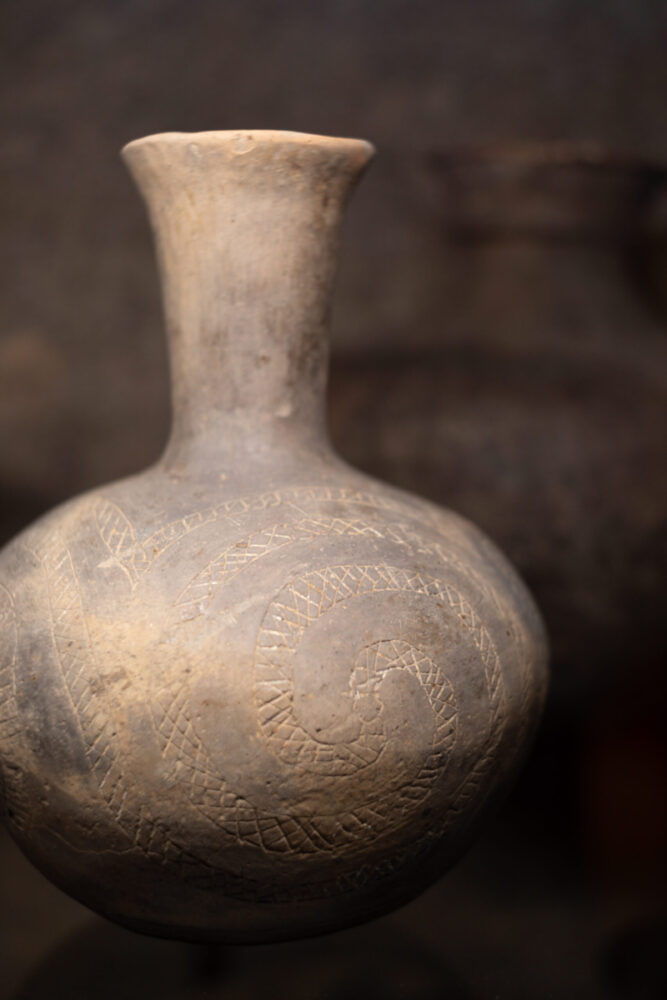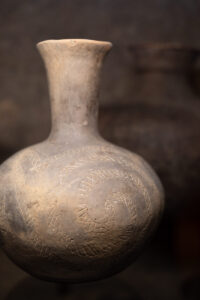Tunica-Biloxi Tribe
The Tunica-Biloxi Tribe is one of only four American Indian groups in Louisiana recognized by the federal government.

Photo by Brian Pavlich.
An incised clay vessel found with the Tunica Treasure.
The Tunica-Biloxi Tribe is one of four federally recognized American Indian tribes in the state of Louisiana. As of 2020 there are approximately 1,500 enrolled tribal members interspersed throughout Louisiana (40 percent), Texas (32 percent), Illinois (7 percent), and other parts of the United States (21 percent). The Tunica-Biloxi Tribe is a successor to the historic Tunica, Biloxi, Ofo, and Avoyel Tribes. These component tribes were allied in the eighteenth century and became amalgamated into a single tribe in the early twentieth century through common interests and outside pressures from non-Indian cultures. The Tunica-Biloxi reservation is located just south of Marksville in east-central Louisiana. Tribal lands comprise approximately 1,717 acres of trust and fee property in Avoyelles and Rapides Parishes. (Trust land is land that the US government holds in trust, maintaining a title on behalf of a federally recognized tribe, and fee-simple land is land held under complete control by a tribe to lease or develop as they see fit.)
Tunicas in Colonial Louisiana
Historians generally agree that a group of Spanish explorers, under the leadership of Hernando de Soto, encountered the ancestors of Tunicas in the province of Quizquiz in 1541. Located in the Yazoo Basin of present-day northwestern Mississippi, the indigenous inhabitants of Quizquiz built mounds of the kind commonly found throughout the Mississippi Valley. They also impressed the Spanish with their military and agricultural capabilities. At that time, the related tribal groups covered a large region extending along both sides of the Mississippi River in present-day Mississippi and Arkansas. Archaeologists tie Tunicas to the Arkansas River Valley and assert that the treasures at Spiro Mound in present-day Oklahoma are as much Tunica as Caddo or Wichita. Tunicas were clearly in the lower Ouachita River basin and across into the Yazoo Basin before European contact. For reasons that are not entirely clear—though probably related to their temporary contact with the de Soto expedition and the long-term impact of disease and famine—the people of Quizquiz moved south to the confluence of the Yazoo and Mississippi Rivers sometime during the late sixteenth century. Indigenous populations were decimated by diseases transmitted by Spanish explorers. Little is known about the period following de Soto, as continued interactions with French and Spanish colonists interrupted the Tunica language and oral traditions.
The French first contacted Tunicas more than a century after the de Soto expedition, near the banks of the Lower Yazoo River. Members of the La Salle expeditions of the 1680s identified Tunicas as enemies of the Quapaws, who resided on the Lower Arkansas River. The first recorded encounter between the French and Tunicas occurred in 1699, when three Roman Catholic missionaries—François Jolliet de Montigny, Jean François Buisson de St. Cosme, and Albert (aka Antoine) Davion—happened upon a group of Tunica villages. The priests described Tunicas as a peaceful, agricultural people with an elaborate religious system oriented around a major temple. Due to cultural and linguistic barriers, however, Jesuit Jacques Gravier noted that Tunicas “are so close-mouthed as to all the mysteries of their religion that the missionary could not discover anything about it.” Davion established a mission among the Tunicas in 1699, where he lived on and off until approximately 1720.
Tunicas made a broad impact on trade and culture in Arkansas, Louisiana, and Mississippi throughout the eighteenth century. Tunicas and Caddos also extended tribal influence in the development of the Texas and the southern Great Plains (in particular, the horse trade). Tunicas were skilled traders and entrepreneurs, especially in the manufacture and distribution of salt, a valuable item to both American Indians and Europeans. The French, who so often experienced supply shortages, relied heavily on the tribe for salt, rice, cattle, and horses. The French also looked to Tunicas for military support against rival tribes such as the Natchez and the Chickasaws. Archaeological and ethnographic records clearly demonstrate a unique and extensive relationship between the French and Tunicas during the French colonial period of Louisiana history. By contrast, the archival and archaeological records for the Spanish period is slight.
Several years after French contact, Tunicas migrated to the vicinity of the Red River-Mississippi River confluence after coming in conflict with the Chickasaws and English. They resettled among the Houmas in an area known as Portage de la Croix (near present-day Angola, Louisiana). In 1706, Tunicas attacked their Houma hosts to develop closer diplomatic and trade relations with the French. In 1731, following the 1729 Natchez revolt, a group of Natchez refugees attacked the main Tunica village, killing several chiefs and convincing the defeated tribe to migrate once again to a tributary of the Mississippi River that is known today as Tunica Bayou.
After the 1763 Treaty of Paris, the tribe left Tunica Bayou after coming in conflict with British forces and allying with the new Spanish regime in New Orleans. In 1764 they settled on the east side of the Mississippi River near Pointe Coupée, though no archaeological record remains due to river encroachment. Approximately twenty years later, Tunicas moved to the interior of Spanish Louisiana in present-day Avoyelles Parish. Since the 1780s the tribe’s main settlement has remained in Marksville, Louisiana.
After the Louisiana Purchase
After the 1803 Louisiana Purchase, the United States committed itself to a policy of protecting American Indian land and rights, but, in reality, it disregarded the smaller Louisiana tribes to appease discontent among former French and Spanish colonists. Once afforded respect and protection by Spain as a sovereign nation, Tunicas lost their land to French and American settlers who registered the land as “unoccupied” so that they could make fraudulent claims to it. In an 1806 report to the US government by American Indian agent John Sibley, there was questionable data dismissing most Louisiana tribes as insignificant “remnants.” Thus, Tunicas escaped the removal policy of the 1830s and 1840s and kept their village on the Avoyelles Prairie.
Tunicas resided in the vicinity of Marksville during the nineteenth and twentieth centuries. Oral history suggests that the Avoyel Tribe welcomed Tunicas into their central-Louisiana community, after which members of the two tribes commonly intermarried. Priests of the Archdiocese of New Orleans, and later the Dioceses of Natchitoches (est. 1853) and Alexandria (est. 1910), regularly visited the American Indians of Avoyelles Parish, though their chapel remained in a ramshackle state for much of the nineteenth century. During the 1950s and 1960s, archaeologist Robert Neitzel and Tunica Chief Joseph A. Pierite Sr. unearthed Tunica burials dating to the nineteenth century. The excavations showed little sign of Christian adherence, thus demonstrating an extension of traditional Tunica lifeways at least to the Civil War and perhaps thereafter.
Following the Civil War, Tunicas lived in farming communities in and around Marksville. The tribe made an official land claim during the 1890s, but the Louisiana Supreme Court ruled against the tribe on the grounds that the US Department of the Interior “had no knowledge of any land set apart for the Tunica or any other Indians for an Indian reservation.” In 1920 another state court ruling found “no official recognition that would segregate [Tunicas] from the rest of the population of the state.” In response to state and federal government rejection, as well as a decline in the number of self-identified people of Tunica descent, Tunicas merged with several other historical Louisiana tribes—including the Biloxi, Avoyel, Ofo, and Choctaw Tribes—to pool their political, cultural, and economic resources for future attempts at official recognition.
Beginning with tribal leader Sesostrie Youchigant in 1911, the Tunica village in Marksville maintained a rather formal system of electing their chief. It was at this time that the tribe began recording the elections in the parish courthouse. Youchigant resigned in 1921, making way for the election of Ernest Pierite as chief and Eli Barbry, Youchigant’s half-brother, as subchief. During Pierite’s time as chief, Tunicas and Biloxis formally joined. On October 9, 1924, the Biloxis recognized Eli Barbry as the leader and authorized him to bring about a union of Tunicas and Biloxis. The death of Sesostrie Youchigant in 1948 marked the decline in use of the Tunica language and the fading away of many traditions.
Legal Recognition and Economic Growth
Tunicas received considerable attention during the 1970s when Leonard Charrier, an amateur archaeologist, excavated thousands of burial objects associated with the Tunica Bayou settlement. Dubbed the “Tunica Treasure” but more formally referred to as the Trudeau site, Harvard researcher Jeffrey Brain and a team of professional archaeologists conducted extensive excavations in 1972, 1980, and 1981. They uncovered artifacts of Indigenous and European origin, including pottery, basketry, glass beads, ceramic bowls, axes, nails, scissors, jewelry, and firearms. Most items were found on or near the bodies of Tunica men, women, and children buried in traditional fashion.
In addition, during the 1970s, leaders of what remained of the coalition of Tunicas and Biloxis decided to pursue federal recognition as a tribe. Earl J. Barbry Sr. was elected tribal chairman in 1978, after which he became the main force behind an appeal to the Bureau of Indian Affairs for acknowledgement of the Tunica-Biloxi Tribe of Louisiana. Federal recognition of the tribe came in 1981, but only after leaders were able to demonstrate the following information to the federal government: the existence of a distinct American Indian community going back several centuries to first contact with Europeans; the identification of a distinct American Indian group since first contact by federal governments, state governments, local governments, other tribes, or scholars; and proof of ancestral links to the historic tribe from which the present one descended. Moreover, Barbry was partly responsible for securing the return of the “Tunica Treasure” to the Tunica-Biloxi Tribe in 1989 in accordance with a state court ruling.
After receiving federal acknowledgement, the Tunica-Biloxi Tribe set out to secure economic independence for its people. Progress was slow until the Grand Casino Avoyelles, now Paragon Casino Resort, opened in 1994. The casino and associated hotel, golf course, and entertainment venues are among the largest employers in the region. Other tribal enterprises include a film finance and production company and an online lending company.
In 1998 tribal leaders started the Tunica-Biloxi Indian Political Action Committee (TBIPAC) to influence state and federal legislation. The administration of the Tunica-Biloxi Tribe includes departments devoted to health, housing, gaming, finances, cultural resources, legal affairs, social services, and education. In 2011 the tribe opened the 40,000-square-foot Tunica-Biloxi Cultural and Educational Resources Center, which includes a museum housing the Tunica Treasure, a gift shop, conservation lab, library, auditorium, distance-learning center, classrooms and meeting rooms, and tribal government offices.
The tribe’s Language and Culture Revitalization Program, created in 2014, provides structural support for language and culture education, as well as a noticeable presence of heritage languages on the reservation and throughout the extended community. Tribal culturalists maintain the tradition of pine needle basketry and beadwork and preserve songs and stories passed down by community elders. The Tunica-Biloxi Nature Trail, a one-mile boardwalk, extends from the casino and administrative complex into the undeveloped natural setting of Coulee des Grues. The Tunica-Biloxi Powwow is held annually on the third weekend in May, with an Education Day featuring interpretive programming and dance demonstrations held the Friday before the powwow begins on Saturday. Though most members of the tribe do not reside on tribal lands, many participate in cultural life through tribal meetings and the annual Tunica-Biloxi Powwow. Tribal programs and facilities enhance the quality of life for Tunica-Biloxi people and provide educational opportunities, housing, and medical services.
The resilience of the Tunica-Biloxi to disease, warfare, displacement, and resettlement is a testament to the tribe’s collective ability to adapt to the social, cultural, and economic upheavals that came with more than four hundred years of colonial activity. Their legacy as entrepreneurs, diplomats, and good neighbors continues today.
